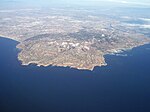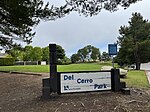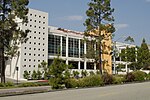Hacienda de la Paz
Houses in CaliforniaHouses in Los Angeles County, CaliforniaHousing in the United StatesNew Classical architecture
Hacienda de la Paz is a large estate property in the city of Rolling Hills, on the Palos Verdes Peninsula in the Los Angeles area of Southern California. It was designed by the 2010 Driehaus Prize winner Rafael Manzano Martos with decorator Manuel Gavira Sanjuan for owner/builder John Z. Blazevich and is Martos' only project in the Americas. Construction began with two parcels of land in 1993 and final completion was not until 2008. It is the 36th largest home ever built in the United States, still standing.
Excerpt from the Wikipedia article Hacienda de la Paz (License: CC BY-SA 3.0, Authors).Hacienda de la Paz
Buggy Whip Drive,
Geographical coordinates (GPS) Address Nearby Places Show on map
Geographical coordinates (GPS)
| Latitude | Longitude |
|---|---|
| N 33.760419 ° | E -118.356906 ° |
Address
Buggy Whip Drive
90274 , Rolling Hills
California, United States
Open on Google Maps










